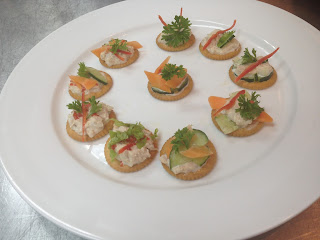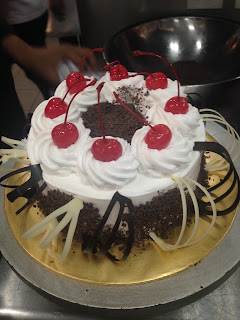INTERNATIONAL CUISINE - WEEK 10 (JAPANESE CUISINE)
Introduction
Japanese Cuisine
-
In
week 10, we have covered the Japanese cuisine. The cuisine that we learn is
bento that has Japanese rice with chicken karage, tempura, salad and teriyaki
sauce. For the sushi we have do three type of sushi that is, California sushi,
onigiri sushi and makizushi sushi.
History of Japanese Cuisine
-
Japanese cuisine encompasses the regional and traditional foods
of Japan, which have developed through centuries of social and economic
changes. The traditional cuisine of Japan (和食 washoku) is based on rice with miso
soup and other dishes; there is an emphasis on seasonal ingredients. Side
dishes often consist of fish, pickled vegetables, and vegetables cooked in
broth. Seafood is common, often grilled, but also served raw
as sashimi or in sushi. Seafood and vegetables are also
deep-fried in a light batter, as tempura. Apart from rice, staples include
noodles, such as soba and udon. Japan also has many simmered dishes such as
fish products in broth called oden, or beef
in sukiyaki and nikujaga.
Dishes inspired by foreign food—in particular Chinese
food like ramen, fried dumplings, and gyōza—as well as foods
like spaghetti, curry, and hamburgers have become adopted with variants
for Japanese tastes and ingredients. Historically, the Japanese shunned meat,
but with the modernization of Japan in the 1880s, meat-based dishes such
as tonkatsu and yakiniku have become common. Japanese
cuisine, particularly sushi, has become popular throughout the world. In 2011,
Japan overtook France in number of Michelin-starred restaurants and
has maintained the title since.
-
Bento (弁当 bentō) is
a single-portion take-out or home-packed meal common in Japanese
cuisine. A traditional bento holds rice or noodles, fish or
meat, with pickled and cooked vegetables, in a box. Containers
range from disposable mass-produced to hand-crafted lacquer
ware. Bento are readily available in many places throughout
Japan, including convenience stores, bento shops (弁当屋 bentō-ya), railway
stations, and department stores. However,
Japanese homemakers often spend time and energy on a carefully
prepared lunch box for their spouse, child, or themselves.
Bentos can be elaborately
arranged in a style called "kyaraben" ("character bento"). Kyaraben are
typically decorated to look like popular characters from Japanese animation
(anime), comic books (manga), or video games. Another popular bento style
is "oekakiben" or "picture bento". This
is decorated to look like people, animals, buildings and monuments, or items such as flowers and plants. Contests are
often held where bento arrangers compete for the most
aesthetically pleasing arrangements.
There are similar forms of boxed lunches in Asian countries
including the Philippines (baon), Korea (dosirak), Taiwan (bian
tang in Mandarin and “bendong” in Taiwanese) and India (tiffin). Also,
Hawaiian culture has adopted localized versions of bento featuring
local tastes after over a century of Japanese influence in the islands.
-
The history
of sushi began with paddy
fields in Asia, where fish was fermented with
salt and rice, after which the rice was discarded. The dish is today known
as narezushi, and was introduced to Japan around the Yayoi
period. In the Muromachi period, people began to eat the rice as
well as the fish. During the Edo
period, vinegar rather than fermented rice began to
be used. In pre-modern times and modern times, it has become a form of fast
food strongly associated with Japanese culture
The
earliest form of sushi, a dish today known as narezushi, has its probable
origin with paddy fields along the Mekong river in Southeast Asia.
The prototypical narezushi is made by lacto-fermenting fish
with salt and rice in order to control putrefaction. Spreading southwards down
the Mekong, narezushi then entered Austronesia. In
Japan the dish's distribution overlaps with the introduction of wet-field rice
cultivation during the Yayoi period. Narezushi appears in the
Chinese dictionary in the 2nd century CE as the character sa (鮓, pickled fish with salt and
rice) which was during a period in which Han people
were expanding south of the Yangtze river,
adopting the food from the non-Han minority peoples
The
Japanese preferred to eat fish with rice, known as namanare or namanari (生成, なまなれ, なまなり, semi-fermented). During
the Muromachi period namanare was
the most popular type of sushi. Namanare was partly raw fish
wrapped in rice, consumed fresh, before it changed flavor. This new way of
consuming fish was no longer a form of preservation but rather a new dish in
Japanese cuisine. During the Edo period, a third type of sushi was
introduced, haya-zushi (早寿司, 早ずし, fast sushi). Haya-zushi was
assembled so that both rice and fish could be consumed at the same time, and
the dish became unique to Japanese culture. It was the first time that
rice was not being used for fermentation. Rice was now mixed with vinegar, with
fish, vegetables and dried food stuff added. This type of sushi is still very
popular today. Each region utilizes local flavors to produce a variety of sushi
that has been passed down for many generations. Today's style of nigirizushi (握り寿司), consisting of an oblong
mound of rice with a slice of fish draped over it, became popular in Edo (contemporary Tokyo)
in the 1820s or 1830s. One common story of nigirizushi's origins is
of the chef Hanaya
Yohei (1799–1858), who invented or perfected the
technique in 1824 at his shop in Ryōgoku. After
the Great Kanto earthquake in 1923, nigirizushi chefs
were displaced from Edo throughout Japan, popularizing the dish throughout the
country.
CONTENT
Recipe: Bento, Rice with Chicken
Karage, Tempura, Salad & Teriyaki Sauce
Karage Chicken Batter
·
All
purpose flour (100gm)
·
Corn
Starch (1 tbsp)
·
Salt
(1 tsp)
·
Cold
Water
Tempura Batter
·
Corn
Starch (1 tbsp)
·
Egg
yolk (1 nos)
·
Cold
Water
Chicken Karage Marinating
·
Ginger
(2 tbsp)
·
Soy
Sauce (1 tbsp)
·
Lemon
(1 tbsp)
·
Vinegar
(1 tbsp)
·
Garlic
(10 gm)
Teriyaki Sauce
·
Soy
Sauce (1/4 cup)
·
Orange
Juice (1btsp)
·
Ginger
(1tbsp)
·
Corn
Starch (1btsp)
·
Butter
(1 ½ cup)
·
Onion
(10gm)
Method
1.
Firstly,
do the chicken karage and tempura batter and set aside. After that, can do the
teriyaki sauce, the ingredient that was used to do teriyaki sauce is soy sauce,
orange juice, ginger, corn starch, butter and onion. Cook until cooked and set
aside.
2.
Cook
the Japanese rice for the rice of bento, 2 cup rice of Japanese rice and the 1
cup of water and cook.
3.
Marinate
the chicken karage used the ingredient ginger, soy sauce, lemon, vinegar and
garlic and set aside
4.
Cook
the shrimp used the tempura batter, before cook the shrimp make sure remove the
skin of the shrimp and cook in deep fry pan, cook until it golden colour or
until the shrimp cooked.
5.
Cook
the marinate chicken karage used karage batter in the deep fry pan, make sure
the fire in the low to make sure the chicken was cooking.
6.
For
the salad used the asparagus, carrot, cabbage, tomato and radish. The
asparagus, carrot and radish cook used the batter. For the tomato just cut in
slice same as the cabbage. After finish all, set aside
7.
Do
the omelette for the side dish for the bento, the ingredient for the omelette
is egg, milk and salt, cook in the right way to make sure that is omelette.
8.
After
finish all, can make the bento used your creative and your own style. Finish
and can serve.
Recipe: Sushi
·
Japanese
rice (1 cup)
·
Japanese
cucumber (1 stick)
·
Carrot
(1 stick)
·
Crabmeat
(1 stick)
·
Seaweed
(1 pieces)
·
Wasabi
(1tsp)
·
Soy
Sauce (1 tbsp)
·
Salt
(1 tsp)
Method
1.
Firstly
cook the Japanese rice, 1 cup of Japanese rice and half of water.
2.
Cut
the carrot and Japanese cucumber into batonnet cut.
3.
The
crabmeat blanches and put in the ice.
4.
After
that, take the seaweed and put the Japanese rice, put the carrot, Japanese
cucumber and crabmeat and then roll that.
5.
Cut
the sushi into small roll and can serve.
CONCLUSION
-
In
the end of the class, we have learnt the student must prepare their self before
entire the class. Other than that, the communication is so important for the
student to communicate to other student. More than that, the important is the
well preparation before class because the well preparation is the started for
the success of the work. Other than that, in the end of class, we have learnt
how to become the SOD in that week, the important part was SOD do is they must
good that to attract and find the customer and they must deliver the order to
the right customer.





Comments
Post a Comment